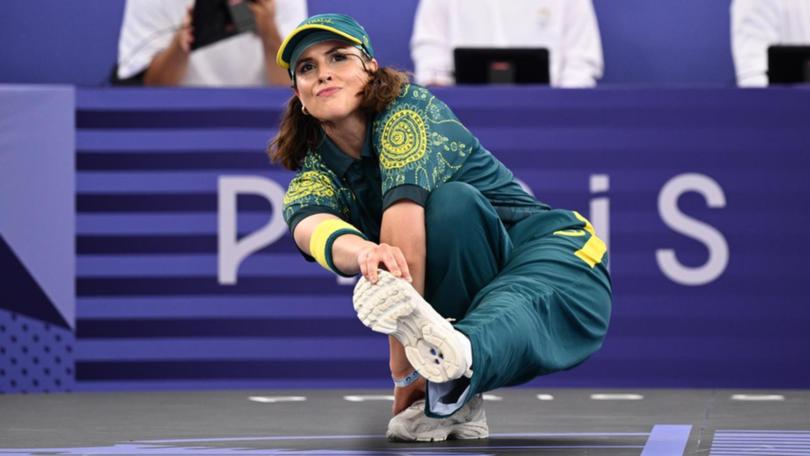Breakers try to move on from Raygun Paris Olympics controversy, at odds with judging: ‘It’s hard to judge’

Raygun may be a national icon and the most famous breakdancer in the world — if for the wrong reasons — but that doesn’t mean her peers want to keep talking about her.
Indeed, it seems her fellow B-Boys and B-Girls are doing all they can to leave Rachael ‘Raygun’ Gunn’s controversial performance at the Paris Olympics behind them.
Two months on from the breakdance that stole the Games, Gunn has mingled with the likes of Richard Branson, been honoured with a statue in Melbourne, and inspired a line of Halloween costumes.
Sign up to The Nightly's newsletters.
Get the first look at the digital newspaper, curated daily stories and breaking headlines delivered to your inbox.
By continuing you agree to our Terms and Privacy Policy.The 37-year-old academic-turned-Olympian told The Project in September she doesn’t want to be “in the spotlight, breaking, competing... for a while”.
And it seems her fellow breakers are done talking about the Raygun of it all, too.
At a panel discussion at SXSW Sydney last week — “Breaking stereotypes — the rise of breaking from the streets to the main stage” — the infamous Aussie B-Girl was not mentioned once
American Olympian Jeffrey ‘B-Boy Jeffro’ Louis joined Australian breakers Gerard ‘B-Boy Kid Tek’ Cabellon and Leah ‘B-Girl Flix’ Clark on the panel and expertly danced around mentioning You-Know-Who for the entire 50-minute session.
The trio discussed how breaking has gone from a Brooklyn hip-hop craze pioneered by DJ Kool Herc in the 1970s to a competitive sport on the biggest mainstream sporting stage in the world: the Olympic Games.
Louis said the community had no idea what to expect from breaking’s cameo in the Games.
“This is the first time breaking has been on a platform like this,” he said, according to news.com.au
“We’re the first wave of breaking being a dance sport.”
But, he said, having a formal judging system in official, competitive battles is something B-Girls and B-Boys are still getting used to.
At the Olympics, breaking battles were assessed under five criteria: technique, vocabulary (i.e. the number and variety of moves), execution, musicality and originality.
Raygun — in case we forgot — scored zero across the board in Paris.
“We’re trying to find what’s the best way to judge breakers because it’s so subjective,” Louis said.
Sometimes it’s not transparent enough to know why the other person won or lost or tied.
Louis, who competed at the 2024 POaris Olympics himself — he lost to the eventual Men’s Breaking silver medallist in the quarterfinals — said judging “varies between competitions”.
“There’s competitions and then there’s jams — we consider those two different things,” he continued.
“Jams are more communal, the cultural side of things where you feel the energy and understand what it’s like to be a breaker.
“The competition, which is a mainstream, high-budget production — that’s more for the general population.”
Even before the Raygun controversy, the International Olympic Committee confirmed breaking would be a one-time-only event.
But the panel suggested the very nature of breaking makes it a challenging sport to judge — unlike gymnastics, for instance — or for casual sport watchers to get into.
Louis said breaking is “a lifestyle — how to be creative, innovative, self-motivated and have your own personal style. All of these things come from hip-hop.”
Aussie ‘B-Boy Kid Tek’ (Gerard Cabellon) said breaking was more a “communal experience” than other competitive sports.
The Western Sydney talent said typical breaking battles are more like a “party ... where people are just vibing, music is playing” and everyone is dancing in a circle until someone gets called out.
“You could be called out, like you’re wearing the same shoes as me but I think I look better, I’m going to call you out, let’s battle. That’s all it can take sometimes,” he said.
“For it to start like that, it’s hard to judge that. It’s hard to turn that into a quantifiable system because it started initially as just pure expression of how you felt at that moment, on that day.”
He said the Olympics had to make a “whole system” to break the scoring down for the public and competitors.
Speaking on how Australia’s breaking style differs from the rest of the world, Cabello said the locals are “known for being kind of wild and crazy and silly”.
“We’ve kind of adapted that into our breaking as well,” he said.
Sounds like a similar justification You-Know-Who gave for her unorthodox moves.
Fellow Aussie panellist B-Girl Flix (Leah Clark) said that all the attention breaking got before and after the Olympics could have the same effect as other times the style has featured in pop culture.
“When those movies like You Got Served came out, it sparked a whole generation of kids coming to dance class and wanting to be in a dance crew,” she said.
“Now with the Olympics highlighting breaking as well, it’s going to spark a whole bunch of new of kids that want to start.”
Raygun may have put Australian breaking on the map, but there were no signs breaking had an uptick — a ‘Raygun Effect’, if you will — at the dance studios that The Nightly contacted after the Paris Olympics.
